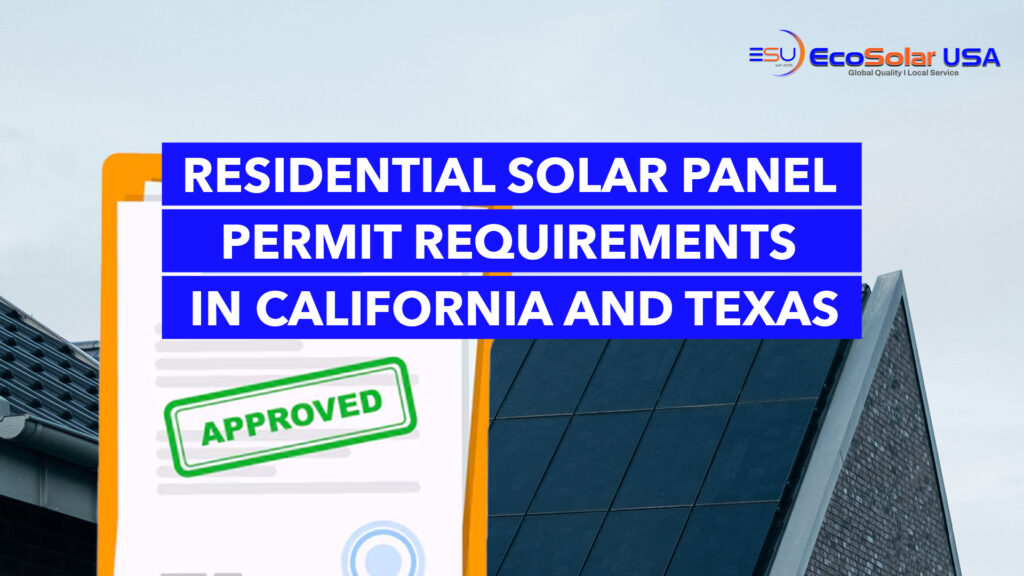
Installing solar panels at home is one of the smartest ways to cut energy costs and reduce your carbon footprint. But before your system can go live, you’ll need to complete an essential step: permits.
For homeowners in California and Texas, the solar permitting process can feel complicated, but understanding what’s required will save you time, money, and frustration.
Residential Solar Panel Permit Requirements
When you install a solar system, most jurisdictions require two key approvals:
- Building Permit
- Ensures panels are safely mounted to your roof and meet structural codes.
- Covers wind load, weight, roof penetrations, and fire access pathways.
- Ensures panels are safely mounted to your roof and meet structural codes.
- Electrical Permit
- Ensures wiring, inverters, disconnects, and grounding meet the National Electrical Code (NEC).
- Often bundled with the building permit.
- Ensures wiring, inverters, disconnects, and grounding meet the National Electrical Code (NEC).
- Interconnection Agreement
- Required by your utility before you connect solar panels to the grid.
- Covers net metering so you can earn credits for sending excess power back.
- Required by your utility before you connect solar panels to the grid.
- Zoning or Planning Approval (if applicable)
- Needed in some areas, especially for ground-mounted systems or historic districts.
- Needed in some areas, especially for ground-mounted systems or historic districts.
The 4 Steps of Solar Permitting Applications and Approval
For most homeowners, the solar permitting process follows these steps:
Step 1: Submit Application
- Your installer submits building/electrical permit applications with plans, site drawings, and equipment specs.
Step 2: Plan Review
- City or county reviews your application to ensure compliance with building codes.
- In California, many jurisdictions use SolarAPP+, which can approve permits in real time.
Step 3: Permit Approval & Installation
- Once approved, your installer begins the solar panel installation.
Step 4: Inspections & Utility Interconnection
- City inspectors review the completed work.
- Utility company grants final permission to operate (PTO).
California vs. Texas: Permit Guidelines for Homeowners
Here’s a side-by-side look at the differences between solar permitting in California and Texas:
| Requirement | California (2025) | Texas (2025) |
| Building & Electrical Permits | Required in all cities/counties. Fees often capped (~$450). | Required in many cities (Houston, Austin, Dallas). Fees vary by jurisdiction. |
| Expedited Permitting | SB 379 requires most cities/counties to offer online automated permits (SolarAPP+). | No statewide system. Approval times vary widely by city/county. |
| Interconnection | Required by utility (PG&E, SCE, SDG&E, etc.). Net metering rules apply. | Required by local utility (Oncor, CenterPoint, etc.). Net metering varies. |
| HOA Restrictions | HOAs may not prevent solar but can require design/placement adjustments. | HOAs cannot prohibit solar (Texas Property Code Sec. 202.010). Limited rules allowed. |
| Approval Timeline | 1 day–2 weeks (expedited) or up to 6 weeks (manual review). | 2–4 weeks typical, longer if multiple departments review. |
Why Proper Permits Matter for Homeowners
- Protect Your Home: Ensures panels are safely installed and roof integrity is preserved.
- Secure Incentives: Rebates, tax credits, and net metering require proof of permits.
- Avoid Penalties: Unpermitted systems risk fines, forced removal, or denied insurance claims.
- Smooth Installations: Prevents delays and costly corrections down the road.
For California homeowners, solar permitting is now faster than ever thanks to SB 379 and SolarAPP+, which allow real-time approvals for many residential systems. In Texas, the process is less standardized, but state laws protect your right to install solar—even in HOA neighborhoods.
By working with an experienced installer who handles permits and interconnection agreements, you’ll enjoy a stress-free path to clean energy and lower bills.
References & Sources:



